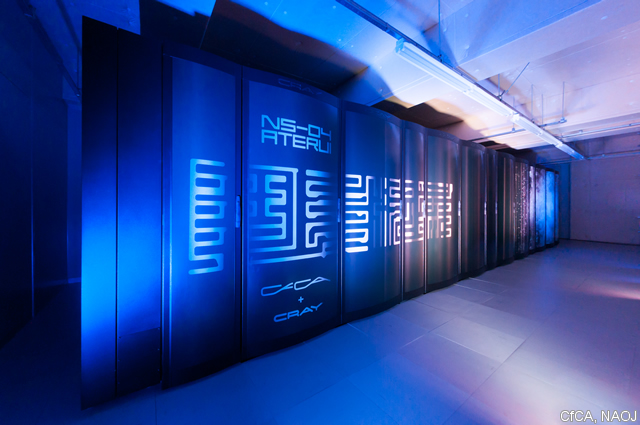The Fastest Supercomputer for Astronomy Just Went into Operation!
| Topics
“XC30 System,” (*1) a supercomputer run by the Center for Computational Astrophysics, National Astronomical Observatory of Japan (CfCA, NAOJ), became fully functional at the Mizusawa VLBI Observatory of NAOJ and opened for open use on April 1, 2013. The XC30 System is the 4th generation of supercomputer to be operated by CfCA. In comparison to the 3rd generation supercomputer, the XT4 System which was introduced by CfCA in 2007, it has about eight times as many CPUs installed to carry out calculations. The full system has realized a theoretical performance peak of 502TFLOPS (*2).
With the introduction of the XC30 System, astronomical research based on numerical simulation is expected to make substantial progress. For example, more detailed structures of celestial bodies can be abstracted through numerical simulations. Also, it will be possible to numerically simulate the evolution of the celestial bodies for longer periods of time. It may be also possible to perform radically new simulations with consideration of physical processes that had been difficult to be included due to limitations in computer performance.
Mizusawa VLBI Observatory with the XC30 System and the NAOJ Mitaka Campus are linked with a high-speed line (*3), and researchers nationwide can remotely access the system. The Mitaka Campus is equipped with analytic servers for analyzing/visualizing the results of simulations made on the supercomputer and file servers for storing computational data.

*1: The system was developed by Cray Japan. For more information please visit:
http://wwwjp.cray.com/products/XC30-01.html (Japanese)
*2: FLOPS (for FLoating-point Operations Per Second) is a unit of computational speed. 1TFLOPS and 1PFLOPS are equivalent to a trillion and a thousand trillion floating-point operations per second, respectively.
*3: New Generation Network Testbed JGN-X. http://www.jgn.nict.go.jp/english/index.html